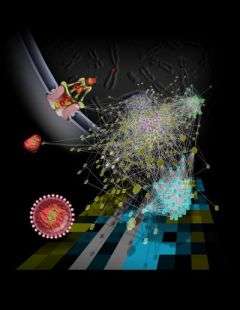What HIV needs: Identification of human factors may yield novel therapeutic targets for HIV

The Salk Institute for Biological Studies and Burnham Institute for Medical Research today announced 295 host cell factors that are involved in human immunodeficiency virus (HIV) infection. The study, published in the Oct. 3 issue of Cell, could lead to the development of a new class of HIV therapeutics aimed at disrupting the human-HIV interactions that lead to viral infection.
The research, a collaborative effort between the laboratories of Sumit K. Chanda, Ph.D, previously at the Genomics Institute of the Novartis Research Foundation (GNF) and now at Burnham and John Young, Ph.D. at Salk, combined several layers of genome-wide analysis to identify cellular proteins that aid the virus in establishing an infection.
"HIV has just nine genes, coding for 15 proteins, compared to bacteria, which harbor several thousand genes, or humans, with over 20,000 genes," said Chanda, associate professor in the Infectious & Inflammatory Disease Center at Burnham and an adjunct faculty member at Salk. "We have known for a long time that HIV hijacks our cellular proteins to complete its life cycle. This study now lays out its flight plan."
Young, professor in the Infectious Disease Laboratory at Salk added, "Due to viral resistance, there is an urgent need for new classes of therapies aimed at preventing the virus from infecting new cells as opposed to merely keeping viral replication in check. To develop more effective therapies for HIV infection and AIDS we must identify and characterize the cellular factors that participate in early steps of HIV-1 replication and prevent the virus from becoming established."
Although more than two dozen drugs are available for the treatment of HIV infection, there is a growing need for new antiviral therapies. Recent studies indicate that HIV remains "hidden" in a latent form, even after long-term suppression with highly active antiretroviral therapy.
In the study, the team of researchers used short-interfering RNA (siRNA) which, when introduced into a cell, silences cellular gene expression, one gene at a time. Using high throughput transfection technology available at GNF and at Burnham, more than 144,000 siRNAs (6 siRNAs for each gene in the human genome) were screened for their effects on HIV-1 infection. Data from the siRNA genomic screen was combined with information from large-scale, protein-protein interaction databases to identify key protein complexes that affect discrete steps in the early stages of HIV infection.
"The integration of these systems-based analyses allowed us to build, for the first time, a functionally validated map of host-pathogen interactions that are required for viral infection," said Renate König, Ph.D., of Burnham, the first-author on the study.
Source: Salk Institute





















